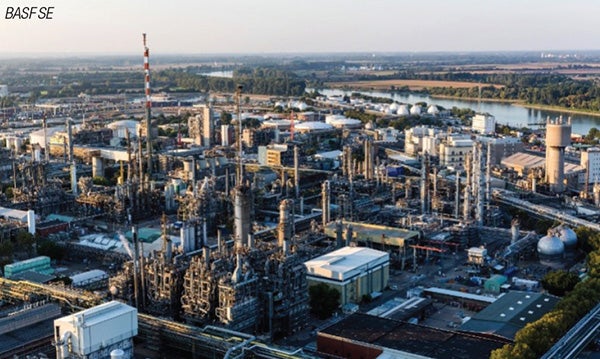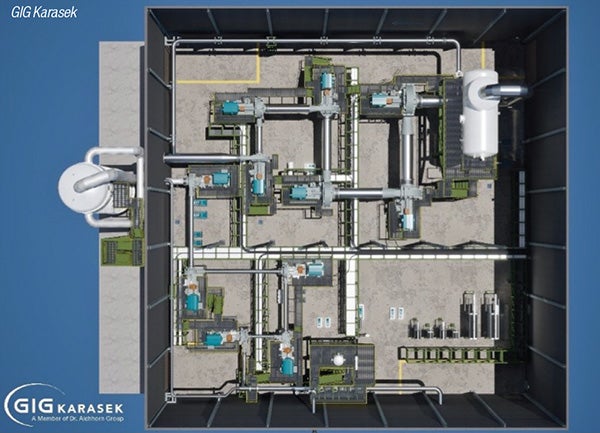Decarbonizing industrial process heat is challenging. Heat pumps offer a path to convert previously unused waste heat into low-carbon steam
Industrial operations are notoriously difficult to decarbonize, but a project currently underway in Germany illustrates that there are viable pathways to substantially reduce the amount of carbon dioxide emissions from existing industrial sites. At its Ludwigshafen site in Germany, BASF SE (www.basf.com) is undertaking one of the most ambitious initiatives to decarbonize industrial process heat in Europe (Figure 1). In close collaboration with GIG Karasek GmbH (Gloggnitz, Austria; www.gigkarasek.com) and PILLER Blowers & Compressors GmbH (Moringen, Germany; www.piller.de), the company is building a large-scale heat pump that converts previously unused waste heat into steam, entirely CO2-free. The plant will prevent up to 100,000 metric tons of CO2 emissions each year, while serving as a scalable international benchmark for driving the green transformation of industry.

FIGURE 1. The heat-pump project is located at BASF’s Ludwigshafen site
Waste heat to steam
BASF has set the goal of achieving carbon neutrality in Germany by 2045. A key focus is the decarbonization of steam generation at its Ludwigshafen site, where 14 million metric tons of steam are produced annually. Fossil energy sources account for approximately 1.4 million metric tons of CO2 emissions.
Today, BASF already covers roughly half of Ludwigshafen’s steam demand through low-carbon heat recovery from chemical processes. For further decarbonization, the company evaluated various generation concepts. The decision for this project ultimately fell on the CompriVAP heat pump system from GIG Karasek, equipped with high-performance VAPOLine® radial compressors from PILLER (Figure 2). This installation marks the first time such a system will be deployed at this scale — both in Ludwigshafen and globally. Commissioning is scheduled for 2027.

FIGURE 2. This is a visualization of the CompriVAP System, with the flash tank, falling-film evaporator and 11-stage MVR compressor cascade
“In addition to cost-effectiveness and decarbonization considerations, high operational reliability and technical flexibility were key factors,” explains Alexander Fronz, project manager for the large-scale heat pump project at BASF. “These qualities make CompriVAP the most compelling overall solution under our specific conditions.”
Heat pump technology
 CompriVAP taps into previously unused waste heat from a steam cracker at the Ludwigshafen facility to produce carbon-free steam, which is distributed through the site-wide steam network. Due to government funding, the primary recipient will be BASF’s formic acid production unit. With thermal power of 50 MW, the system generates up to 500,000 metric tons of steam per year. As a technical pilot project with industrial scale, it remains unique worldwide.
CompriVAP taps into previously unused waste heat from a steam cracker at the Ludwigshafen facility to produce carbon-free steam, which is distributed through the site-wide steam network. Due to government funding, the primary recipient will be BASF’s formic acid production unit. With thermal power of 50 MW, the system generates up to 500,000 metric tons of steam per year. As a technical pilot project with industrial scale, it remains unique worldwide.
“We are talking about one of the most powerful industrial heat pumps worldwide — and yet, in terms of our total CO 2 emissions, it’s only a small piece of the puzzle. But it’s a significant one: being able to deliver a viable heat pump solution at this scale is, for me personally, a true milestone,” says Tim Lerch, project execution owner at BASF.
CompriVAP is not a stand-alone machine, but an integrated heat pump solution that combines proven technologies into one system. The concept is based on mechanical vapor recompression (MVR), in which steam is raised to a higher energy level by electrically driven compressors and then supplied as process heat (Figure 2).
“Unlike many commercially available heat pump solutions, which are primarily designed for hot water production, CompriVAP has been purpose-built from the ground up for steam generation,” explains Martin Schmid, process engineer at GIG Karasek and part of the project team since its inception.
“The technology is based on MVR, explicitly developed for steam applications, and this is where it truly demonstrates its full potential,” he continues.
While each component used in the system has been proven individually, the real challenge lies in integrating them into one stable, continuously operating system. This creates special demands for risk management — both in the process itself and in the control concept. Project leaders therefore made a deliberate decision not to pursue overly ambitious efficiency targets, focusing instead on building a robust, feasible system.
“For this first-of-its-kind application, the priority is not on pushing individual components to the limits of technical feasibility, but on delivering a fully integrated solution that ensures reliable performance,” says BASF’s Fronz.
Collaborative project
A project of this scale cannot be accomplished single-handedly. BASF therefore intentionally partnered with specialized companies to bring the large-scale heat pump to life.
GIG Karasek is responsible for both the process engineering development and the execution as an EPC (engineering, procurement & construction) service provider. Building on a preceding feasibility study, the company supports every project phase — from conceptual design through commissioning. Its scope of service covers everything from standard components to plant elements customized for the project. Special attention is placed not only on optimally sizing individual components, but above all on their functional integration into a perfectly coordinated overall system.
“As a project partner, we don’t just supply BASF with individual components, we provide a comprehensive solution that delivers technologically, economically, and in day-to-day operations long-term,” explains Markus Putz, project manager at GIG Karasek.
 For the MVR process, PILLER delivers an 11-stage VAPOLine® compressor system — split into two cascades (6 + 5 units) to provide better control of steam dynamics and minimize oxygen ingress. This architecture enables partial-load operation without the need for bypassing or recirculation of the vapors. Despite the challenges of switching to water-cooled drives, PILLER succeeded in standardizing key components — a clear advantage for both maintenance and system availability. In roughly a year, the project will enter its next exciting phase: delivery and installation of all eleven machines — in just three days.
For the MVR process, PILLER delivers an 11-stage VAPOLine® compressor system — split into two cascades (6 + 5 units) to provide better control of steam dynamics and minimize oxygen ingress. This architecture enables partial-load operation without the need for bypassing or recirculation of the vapors. Despite the challenges of switching to water-cooled drives, PILLER succeeded in standardizing key components — a clear advantage for both maintenance and system availability. In roughly a year, the project will enter its next exciting phase: delivery and installation of all eleven machines — in just three days.
“Every component has to be a perfect fit — not just for optimal efficiency, but also to perform reliably across a wide operating range,” says Oscar Sgrott, senior process engineer at PILLER.
Close collaboration between BASF, GIG Karasek, and PILLER was a key success factor during the engineering phase — especially in critical moments such as the shift from the original open system design to the current hybrid configuration. “The speed and professionalism with which an alternative plant concept was jointly developed and integrated was truly impressive,” recalls BASF’s Fronz.
All project partners share a deep understanding of the initiative’s significance: it’s not only about technical feasibility, but about proving that large-scale industrial waste heat recovery works in practice. “We all feel the responsibility – and that’s exactly what drives this unique dynamic,” says Fronz. “What unites us is the shared determination to make something truly new possible.” Without that spirit, he concludes, a project like this simply couldn’t be realized.
Funding and outlook
BASF already relies on renewable energy, yet without funding from the German Federal Ministry for Economic Affairs and Climate Action (BMWK) climate protection contracts, this project would not be economically viable — partly due to the high efficiency of existing plants.
The added value lies in improving the Product Carbon Footprint (PCF) of the portfolio. “Green steam will become a competitive advantage,” says Alexander Fronz. “The funding bridges the gap until the market rewards climate-friendly products.”
Climate-neutral process heat will be essential for securing market access in the future. “Projects like this showcase Europe’s innovative strength,” emphasizes Tim Lerch. “A future-proof industry is being built here too — not just elsewhere.”
The large-scale heat pump in Ludwigshafen is more than a single milestone: it marks the starting point for a scalable solution with international relevance. As the first reference system of its size, it lays the foundation for further applications in energy-intensive industries. What is regarded today as a technological pioneering project will need to become standard tomorrow. The transformation toward a climate-neutral industry cannot be postponed — it begins with concrete steps taken here and now.
Edited by Scott Jenkins
Author
Eveline Stopfer, writing for GIG Karasek (Neusiedlerstrasse 15, 2640, Gloggnitz, Austria; Website: www.gigkarasek.com; Phone: +43-2662-42780). Multiple persons from the heat-pump project team of industrial process technology supplier GIG Karasek contributed to this article. The team is responsible for the process engineering and the execution as an EPC service provider.